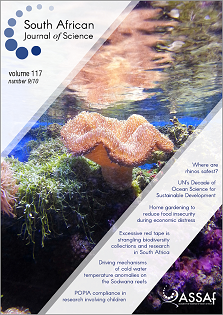Impact of heat and moisture stress on crop productivity: Evidence from the Langgewens Research Farm
DOI:
https://doi.org/10.17159/sajs.2021/8898Keywords:
total factor productivity, climate, rainfed arable farming, experimental farm environment, Langgewens Research FarmAbstract
We investigated the effect of heat and moisture stress on total factor productivity in crop farming under experimental farm conditions. Heat stress is the number of days during the growing season during which the maximum temperature exceeds 24.9 °C. Total rainfall is treated as a basic factor of production and periodic moisture stress, or lack thereof, is the number of rainfall days during the growing season. All models controlled for the cumulative soil benefits arising from minimum tillage, which is the main objective of the experiment. Model specification was evaluated using likelihood ratio tests and three are worthy of note. The study site received 329 mm of rainfall on average on 22 rainy days per season during the period 2002–2015, while the maximum temperature typically rose above 24.9 °C on 33 days per growing season. The average efficiency of the plots in the long-term crop rotation experiment increased at 3.4% per year from a base of 60% to the most recent level of 78%. Neither heat nor moisture stress changed significantly over the study period. Heat stress was found to reduce efficiency by 1.75% per hot day and rainfall increased efficiency by 1.45% for each additional rainy day. However, the interaction of heat and moisture stress lowered productivity overall.
Significance:
- This study contributes a new approach to modelling the effect of climate on agricultural productivity using a new metric of heat and moisture stress.
- We quantify the marginal effects of rising temperatures and rainfall events and evaluate several potential specifications of heat and moisture stress variables.
Published
Issue
Section
License

This work is licensed under a Creative Commons Attribution 4.0 International License.

All articles are published under a Creative Commons Attribution 4.0 International Licence
Copyright is retained by the authors. Readers are welcome to reproduce, share and adapt the content without permission provided the source is attributed.
Disclaimer: The publisher and editors accept no responsibility for statements made by the authors
How to Cite
- Abstract 553
- PDF 512
- EPUB 162
- XML 151












.png)